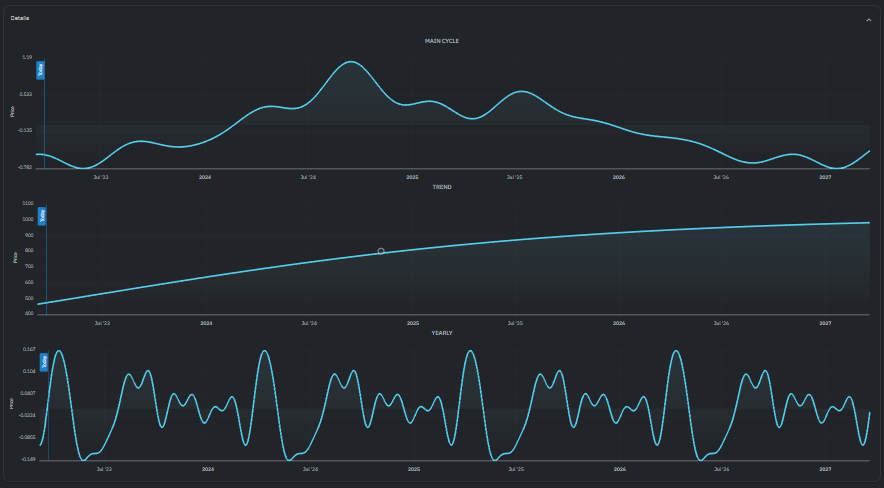20 Excellent Suggestions For Picking AI Stock Trading Websites
20 Excellent Suggestions For Picking AI Stock Trading Websites
Blog Article
Top 10 Tips When Looking At The Cost And Price For Ai Analysis And Stock Prediction Platforms.
Analyzing the costs and prices of AI stock predicting/analyzing trading platforms is vital to ensure you get the most for your money while avoiding hidden fees or unanticipated expenses. Understanding the price structure is crucial to making an informed choice. Here are the top 10 suggestions for evaluating the price and cost of these platforms:
1. Learn more about the pricing structure
Subscription-based: Determine whether the platform has a monthly or annual fee and what features are available on each level.
Pay-per-use: Verify if the platform charges depending on the amount of the usage (e.g. the amount of transactions, requests for data or forecasts).
Freemium model: Check whether it provides a free level with limited functionality and charges for premium functions.
2. Compare Pricing Tiers
The features offered in each price level (e.g. basic professional, professional, and enterprise).
Scalability. You must ensure that you have the appropriate pricing for your needs.
Upgrade flexibility: See whether you are able to easily upgrade or downgrade your plan when your requirements alter.
3. Evaluate Hidden Costs
Data charges: Find out if are required to pay for accessing premium data.
Brokerage fees Check if the platform has additional charges for trading or integrate with brokers.
API usage: Determine if API access costs are more expensive or if API use is very frequent.
4. Demos as well as Trials are Free to Download
Trial period - Search for platforms which offer the option of a trial or demo so you can test the features before you decide to sign up.
The trial's limitations: Check if the trial includes all features, or if there are limitations in terms of capabilities.
There is no commitment option If you do not like the program, you may cancel it without any charge.
5. Find out about discounts and promotions.
Discounts for annual plans: Check whether there are any specials offered by the platform compared to their monthly plans.
Referral Programs: Find out if your platform offers discounts or credits to users who refer others to it.
Inquire about institutional or bulk prices if your business is a large one.
6. Calculate the Return on investment
Cost vs. Value: Determine whether the capabilities and forecasts of the platform are worth its cost. For example, does it assist you in making better trading decisions or help you save time?
Track record of performance: Look at the platform's rate of success or user feedback to determine the ROI potential.
Alternative costs - Compare the platform's price with the cost that could be incurred for not using it (e.g., missed opportunity, time spent on manual analysis).
7. Review Cancellation and Refund Policies
Conditions of cancellation: Make sure that you're able to make a cancellation without hidden costs or penalties.
Check if there is a refund policy for subscriptions you haven't used.
Auto-renewal: Determine that the platform is automatically renewing your subscription, and how you can opt out.
8. Assess Transparency in Pricing
Clare pricing: Make sure that the platform's pricing is clearly stated and contains no hidden charges.
Customer Support: Contact customer service for clarification of any unclear pricing information or added costs.
Contract Terms: Review the contract terms to determine if there are any penalties or long-term obligations.
9. Compare with Competitors
Comparing features and prices of different platforms is an excellent way to make sure you're getting the best price.
User reviews: Read user feedback and see whether other users agree that it's worth the effort.
Market positioning: Check if the platform is priced as premium, mid-tier or a budget choice and if it aligns with your expectations.
10. Consider the Long-Term Costs
Price increases: Find out whether there is a pattern of price increases and the frequency at which they occur. often they occur.
Additions to your plan: Determine if you need an upgrade or if the new features are already included within your existing plan.
Costs of scaling: Make sure the pricing of your platform is reasonable when your trading or data requirements grow.
Bonus Tips:
Free trials for various platforms are available to try and evaluate the benefits and performance of different platforms.
Negotiate pricing: If you're frequent user or a member of an institution, inquire about special pricing or discounts.
You can find free educational sources on certain platforms.
These guidelines will allow you to assess the price and cost of AI trading platforms that can predict or analyze stock prices. So you'll be able pick the best platform that fits your budget, and offers the features and performance you need. A reasonable price for a platform should be able balance affordability with performance. This will allow you to get the most out of your trading. Follow the top my sources for more examples including trading with ai, ai for copyright trading, best stock analysis website, trade ai, stock analysis app, ai for investing, ai stock prediction, best ai trading platform, invest in ai stocks, ai investment stock and more.
Top 10 Ways To Evaluate The Regulatory Conformity Of Ai Stock Predicting/Analyzing Trading Platform
When it comes to evaluating AI trading platforms, compliance with regulatory requirements is a crucial aspect. Compliance ensures that a platform adheres to financial regulations, and operates within legal frameworks while safeguarding user data. This minimizes the chance of legal or financial issues. Here are the 10 best suggestions for evaluating the compliance with regulations of these platforms:
1. Verify licensing and registration
Regulatory bodies: Ensure your platform is registered and licensed by relevant financial regulatory authorities (e.g., SEC in the U.S., FCA in the UK, ASIC in Australia).
Broker partnerships: Verify that brokers integrated with the platform are licensed.
Public records: Go to the regulatory body's website for the status of registration as well as any previous violations.
2. Measure Data Privacy Compliance
GDPR: When operating in the EU or providing services to EU users the platform must be in compliance with the General Data Protection Regulation.
CCPA - California Consumer Privacy Act: Verify compliance for California users.
Data handling policies: Read the privacy policies for data on the platform to see what it says about the data collection, storage and sharing.
3. Assessing Anti-Money Laundering measures
AML policies: Make sure that your platform is equipped with robust AML policy that can detect and stop any form of money laundering.
KYC procedures: Verify whether the platform is following Know Your Customer (KYC) procedures to verify user identities.
Transaction monitoring: Verify that the platform tracks transactions to detect suspicious behavior and notify authorities.
4. Check for your compliance with Trading Regulations
Market manipulation: Ensure that the platform is armed with measures to prevent market manipulation, such as wash trading or the spoofing.
Types of orders: Make sure that the website is compliant with the regulations regarding types of orders.
The best execution: Ensure that the platform is using top execution methods to make trades at a competitive price.
5. Cybersecurity compliance assessment
Data encryption: Ensure that the platform protects users' data while it is in transit as well as when it is in rest with encryption.
Incident response: Verify that the platform has a crisis response plan in place for cyber-attacks and data breaches.
Certifications: Find out if a platform has been certified for cybersecurity (e.g. ISO 27001, SOC 2)
6. Transparency Evaluation and Transparency Evaluation and Disclosure
Disclosure of fees: Ensure that the platform discloses all charges, including any hidden or extra fees.
Risk disclosure: Make sure that the platform provides explicit risk disclosures, particularly for high-risk or leveraged trading strategies.
Performance reporting: Make sure the platform provides transparent and precise performance data for its AI model.
7. Check for compliance with International Regulations
International trading If you're trading internationally, make sure that the platform you use is in compliance to all laws and regulations.
Tax reporting: Find out whether the platform has tools or reports that aid users in complying with tax laws (e.g., FIFO rules in the U.S.).
Sanctions compliance: Ensure that the platform is compliant to international sanctions and does not permit trading only with the countries or entities that are banned.
8. Examining Audit trail and Record-Keeping
Transaction records: Verify that the platform maintains detailed records for regulatory purposes and audit purposes.
Logs of user activity (logs): Check to check if the platform records user activity such as transactions and logins. Also, verify if the account settings have changed.
Audit readiness: Determine whether your system can produce the necessary logs and documentation in the case of an inspection by a regulatory agency.
9. Evaluation of Compliance AI Specific Regulations
Algorithmic rules for trading If the platform for trading has algorithms, make sure it complies to the regulations of MiFID II for Europe or Reg. SCI for the U.S.
Fairness and Bias: Examine to see if there are any biases that the AI platform is able to control and minimize within the AI model. This will ensure fair and ethical trade.
Explainability: As stipulated by certain regulations, the AI platform must provide clear explanations of AI-driven predictions and decisions.
Examine the User Feedback and the Regulatory Histories
User feedback: Review user reviews to assess the credibility of the platform in terms of compliance with regulations.
Regulatory history - Check to determine if the website has been convicted of any previous penalties or violations of regulations.
Third-party auditors: Check if the platform is regularly audited by third parties to make sure it is adhering to rules and regulations.
Bonus Tips
Consultations with a lawyer: You may consider consulting a lawyer in order to establish if the platform is compliant with relevant regulations.
Free trial period: You are able to avail a demo or a free trial to try out the compliance features of the platform as well as its documentation.
Customer support: Ensure the platform offers support for compliance-related queries or issues.
By using these tips you can assess the degree of compliance with regulations within AI stock trading platforms. This allows you to choose a company which is legal and safeguards your interests. The compliance not only reduces the risk of legal liability, but also increases trust in a platform's service. Check out the top best ai for trading hints for site examples including copyright ai bot, ai day trading, invest in ai stocks, ai stock trading bot free, free ai tool for stock market india, investment ai, ai trader, ai copyright trading bot, best ai stocks to invest in, stock predictor and more.